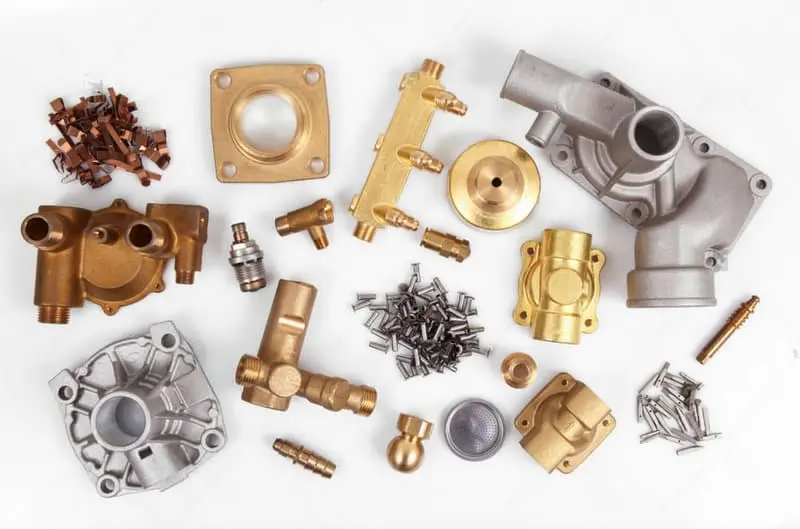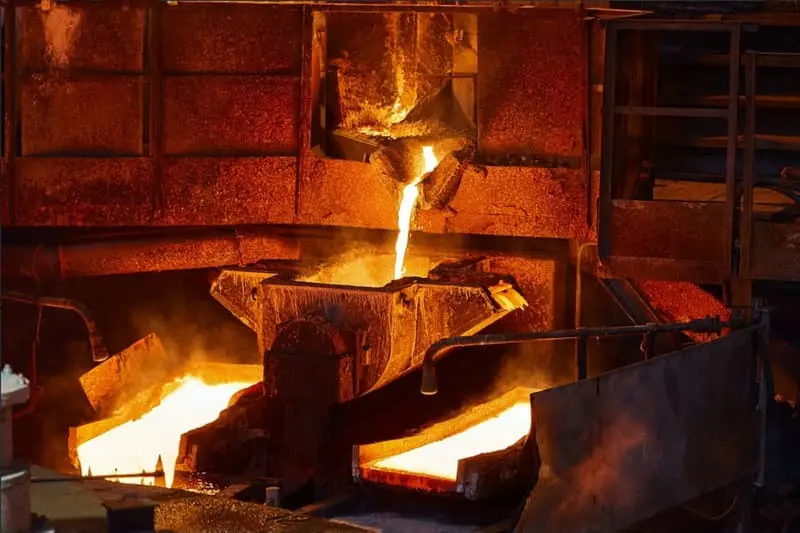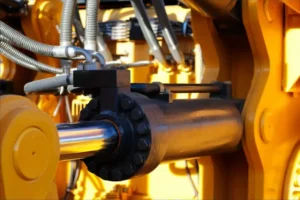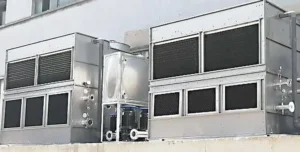Iba't ibang uri ng tanso at mga haluang metal nito ay may iba't ibang mga punto ng pagtunaw. Ang purong tanso ay natutunaw sa mga 1085 mga degree Celsius, Ngunit ang mga karaniwang haluang metal ng tanso tulad ng tanso at tanso ay may iba't ibang mga punto ng pagtunaw.
- tanso (haluang metal na tanso at tin): Ang punto ng pagtunaw ay karaniwang nasa pagitan ng 850 at 950 mga degree Celsius, depende sa komposisyon ng haluang metal.
- tanso (tanso at sink haluang metal): Ang punto ng pagtunaw ay karaniwang nasa pagitan ng 900 at 940 mga degree Celsius, at nag iiba rin ito depende sa zinc content.
Pagkatapos matunaw, ito ay karaniwang pinoy, cast, at pinalamig upang matiyak ang kalidad at katangian ng paghahagis.
Pagpipino: Sa panahon ng proseso ng pagtunaw, maaaring makagawa ng mga karumihan. Ang mga impurities ay maaaring alisin at ang kadalisayan ng tanso ay maaaring mapabuti sa pamamagitan ng pagdaragdag ng mga ahente ng pagpipino o paggamit ng isang vacuum o hindi gumagalaw na kapaligiran ng gas.
Paghahagis: Ang tinunaw na tanso ay ibinubuhos sa isang paunang inihanda na hulma upang mabuo ang nais na hugis. Depende sa casting method, buhangin paghahagis, metal amag paghahagis, o iba pang mga proseso ay maaaring mapili.
Paglamig: Matapos ang paghahagis ay lumamig sa amag, ito ay karaniwang demolded. Ang hakbang na ito ay nangangailangan ng pag aalaga upang maiwasan ang pinsala sa paghahagis.
Pagkatapos ng pagpoproseso: Pagkatapos ng paglamig, Ang mga paghahagis ng tanso ay maaaring sumailalim sa mga kasunod na proseso tulad ng deburring, buli na, at heat treatment upang mapabuti ang kanilang kalidad ng ibabaw at mekanikal na mga katangian.

Pagpipino ng Tanso
Ang pagpipino ng tanso ay higit sa lahat upang alisin ang mga impurities at mapanganib na mga elemento mula sa tinunaw na tanso upang mapabuti ang kadalisayan at pagganap nito.
- Natutunaw na: Matunaw ang tanso sa mataas na temperatura upang maging likido ito. Sa yugtong ito, Mga Ahente ng Fluxing (tulad ng mga fluorides) maaaring idagdag upang makatulong na alisin ang mga impurities.
- Paggamot ng gas: Paggamit ng mga inert gas (tulad ng argon) o vacuum kapaligiran ay maaaring mabawasan ang mga epekto ng oksihenasyon at reaktibo gases, sa gayon ay mapabuti ang kalidad ng tanso.
- Dephosphorization: Kung ang tanso ay naglalaman ng posporus, Maaari itong alisin sa pamamagitan ng pag init o pagdaragdag ng mga tiyak na kemikal. Ang labis na posporus ay maaaring maging sanhi ng tanso na malutong.
- Electrolytic pagpipino: Sa electrolytic cell, ang tinunaw na tanso ay ginagamit bilang anode at ang purong tanso ay ginagamit bilang katod. Pagkatapos ng kapangyarihan ay inilapat, purong tanso dissolves mula sa anode at deposito sa katod, at mga impurities ay nananatili sa electrolytic cell. Ang electrolytic refining ay maaaring makamit ang napakataas na kadalisayan ng tanso (karaniwan ay higit pa sa 99.9%).
tanso paghahagis
Ang paghahagis ay ang proseso ng pagbubuhos ng tinunaw na tanso sa isang hulma upang bumuo ng isang tiyak na hugis.
- Paghahanda ng amag: Piliin ang angkop na materyal na magkaroon ng amag (tulad ng amag ng buhangin, metal magkaroon ng amag o plaster magkaroon ng amag), at tiyakin na ang ibabaw ng amag ay makinis at tuyo upang maiwasan ang paghahagis mula sa malagkit.
- Natutunaw na tanso: Init ang tanso sa isang natunaw na estado sa isang pugon, pagtiyak na ang temperatura nito ay pare pareho at pag iwas sa mga malamig na spot.
- Paghahagis: Ibuhos nang mabuti ang tinunaw na tanso sa hulma, at ang tanso na may magandang likido ay maaaring punan ang bawat detalye ng amag. Sa panahong ito, ang bilis ng paghahagis at anggulo ng pagkiling ay kailangang kontrolin upang mabawasan ang mga bula at depekto.
Paglamig ng Copper
Ang paglamig ay isang mahalagang hakbang sa proseso ng paghahagis. Ang pangunahing layunin ay upang ibahin ang anyo ng tinunaw na tanso mula sa likido hanggang sa solid upang mabuo ang nais na hugis at mga katangian.
- Natural na paglamig: Ang paghahagis cools natural sa magkaroon ng amag, karaniwan sa pamamagitan ng init kondaksyon ng hangin o magkaroon ng amag materyal. Ang natural na paglamig ay mas mabagal at tumutulong na mabawasan ang panloob na stress.
- Pinilit na paglamig: Sa ilang mga kaso, Ang sapilitang paglamig ay maaaring isagawa gamit ang media tulad ng tubig o hangin upang mapabilis ang proseso ng paglamig. Ito ay maaaring mapabuti ang kahusayan ng produksyon, Ngunit ang paglamig rate ay kailangang kontrolin upang maiwasan ang thermal stress mula sa nagiging sanhi ng mga bitak.
- Oras ng paglamig: Ang oras ng paglamig ay depende sa kapal, hugis at materyal ng paghahagis. Ang makapal na castings ay nangangailangan ng mas mahabang oras ng paglamig upang matiyak ang pare pareho ang solidification.
- Pagsubaybay sa temperatura: Sa panahon ng proseso ng paglamig, Mahalagang subaybayan ang mga pagbabago sa temperatura ng paghahagis upang matiyak na ito ay solidifies tulad ng inaasahan.
- Pag aalis ng amag: Matapos ang paghahagis ay lumamig sa isang sapat na katigasan, ang amag ay maaaring alisin.
Pagkatapos ng pagpoproseso
Ang proseso ng post processing ng tanso ay karaniwang kasama ang mga sumusunod:
- Pag deburring: Matapos ang paghahagis ay inalis mula sa amag, maaaring may matatalim na burrs sa mga gilid. Ang deburring ay karaniwang ginagawa sa pamamagitan ng mga mekanikal na pamamaraan (tulad ng paggiling, pagputol ng) o mga pamamaraang kemikal (tulad ng pag aatsara) upang matiyak ang kaligtasan at mapabuti ang hitsura.
- Paggamot sa ibabaw: Ang mga paghahagis ng tanso ay maaaring malinis at makintab upang alisin ang mga layer ng oksido at iba pang mga contaminants at mapabuti ang ibabaw ng gloss. Kabilang sa mga karaniwang pamamaraan ang mekanikal na buli, kemikal buli at electrolytic polishing.
- Lunas sa init: Ang paggamot ng init ay maaaring mapabuti ang mga katangian ng makina ng tanso, tulad ng pagtaas ng lakas at katigasan. Ang mga karaniwang pamamaraan ng paggamot sa init ay kinabibilangan ng annealing (pag init na sinusundan ng mabagal na paglamig) at pagpapawi ng (mabilis na paglamig), ang tiyak na pagpipilian ay depende sa haluang metal komposisyon at dulo ng paggamit ng tanso.
- Patong na patong: Upang mapabuti ang paglaban sa kaagnasan o palitan ang hitsura, copper castings ay maaaring pinahiran, tulad ng electroplating, pag spray o pagpipinta. Ito ay maaaring magbigay ng karagdagang proteksyon at mapabuti ang hitsura ng tanso.
- Inspeksyon at kontrol sa kalidad: Pagkatapos makumpleto ang post processing, ang mga castings ay sasailalim sa iba't ibang inspeksyon (tulad ng visual inspection, ultrasonic inspeksyon, Inspeksyon sa X ray, atbp.) upang matiyak na natutugunan nila ang mga kinakailangan sa disenyo at pagganap.








